My beliefs and principles are often tested by outdoor experiences. I would like to be able to tell you that by now, I’ve got the systems sussed and my approach sorted. Only it doesn’t seem to work like that. Every group of children is different. Every outdoor space is different. So I am constantly being challenged.
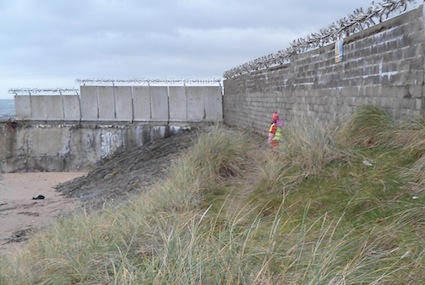
Recently the concrete slope at the beach gave me an internal uphill struggle with myself. In the photo above you can see its profile. It’s a large outcrop of lumpy, bumpy stones set in concrete and is part of the coastal defences to stop the waves eroding the land around the end of the sea wall. There is a path that leads from the beach to the top of the hill. Before you know it, you are at the top of the concrete slope. In the photo below the children (aged 3 and 4yrs old) found themselves there more by default than intent on their first visit. Have a look at the girl on the left. You can see from her body language that she is a little unsure about walking along up there.
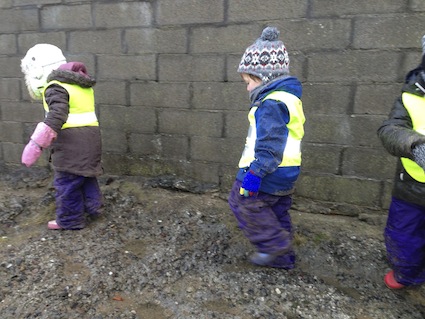
When the children finally met the sea wall, they were faced with a choice. Do they turn around and retrace their steps or do they go down the concrete slope?
For me I had wrestled with this situation prior to the beach visits going ahead. I knew the children would discover the path leading to the top of the hill. I knew this would result in a decision where they were most likely to go down the hill. I knew that although the surface was grippy even in wet weather, if these children take a tumble then it could be quite a nasty bumpy journey to the bottom.
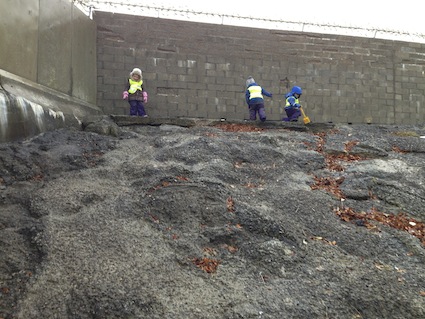
I didn’t want to stop the children going from along the path or down the slope. I felt it was the sort of situation that the children needed to experience, because it’s a life skill. You find yourself in a tricky situation and you have to make a personal decision over what you are going to do.
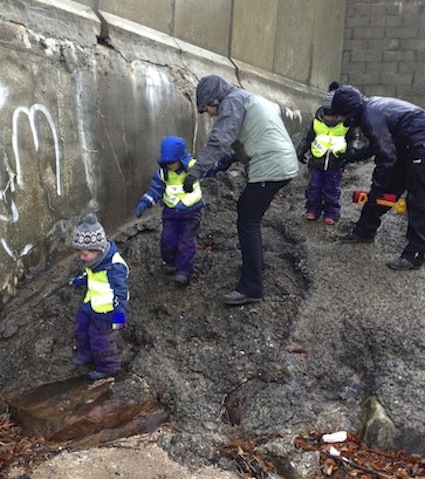
As you can see from the photo above, the practitioners did a normal thing. When they realised what the children had decided to do, they rushed in to support. After all that’s what we do in pre-school, right? We support the children in their decision-making. And we don’t want the children to take a nasty tumble. There are repercussions if this happens such as feelings of guilt, of inadequacy or incompetency. We would blame ourselves and feel awful for the children and then we have to face the parent or carer, who may or may not be sympathetic.
At this point I stepped in and asked the practitioners to step back from the children. Rather than physically support them by holding their hands, I asked them to spot them instead. To walk beside them and just stick out a hand if the child looked like they were going to fall. My rationale was that the children will learn more easily how to balance and walk down the concrete slope if we are a little more hands off.
It was a very very difficult thing to do. The children were used to being helped. Moments before, the girl had been with me. She was very wobbly indeed and fell forward several times. At one point she said in a small voice, “This is very scary.” And I had to agree with her.
And that was it. The following two visits, no child went near the concrete hill either at the bottom or at the top. It seemed to have been enough of a big experience, thank you very much.

So this week, it was interesting to see the girl actively decide to go back up to the top of the concrete slope. Only this time, look at her body language. She is clearly much more comfortable than previously.
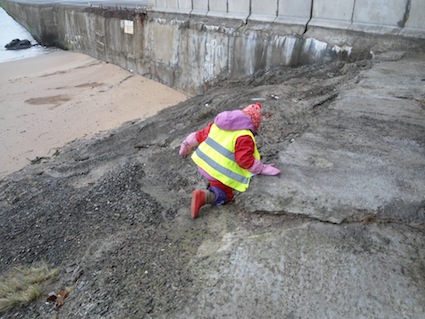
She knew what to expect and had made a plan.
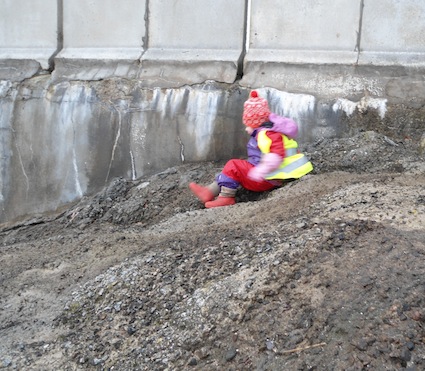
Another child had watched the girl go up and wanted to come along too. He waited and watched how she got down and decided to have a go himself. At this point you can see there are no adults around.
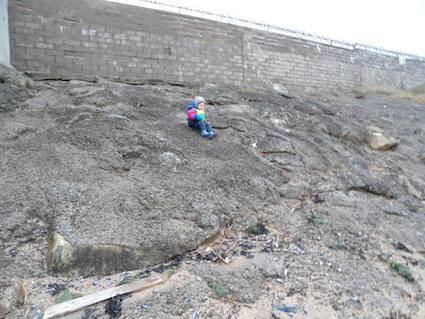
Halfway down, he realised he could walk. Up he got and down he came. All by himself too.
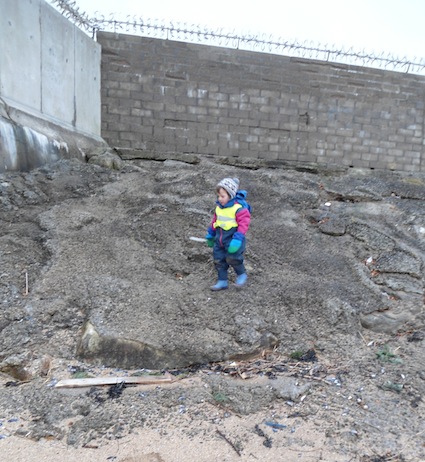
It made me realise just how much progress, not only the children had made in terms of their acclimatisation and confidence but also the adults. That we were able to let the children be. This has been one of the key points of the beach visits. That the adults need time, patience and support to get used to being in a different place and to meet the different challenges which come with this too.
One of the bits of paperwork I have done, is to break the visits down into micro routines that focus on the little things we can do to enable children to become more independent. For me this is important in terms of children developing personal safety skills. Very often, as adults we fail to think about the tiny changes we can make that can have a positive lasting effect, such as deciding not to hold a hand but to spot, in this instance. For me, this is a long term and proactive approach to ensuring children are safe when out and about.




















What an amazing learning journey for these children & the adults. I think you have hit the nail on the head with your point about being torn between the repercussions of allowing children to be in situations where they may/will get hurt. But what I love most is the photo of the little girl with her arms out for balance, a very common phrase I hear children chanting in my setting! Great post as ever Juliet, hoping you’ll link it up to the Outdoor Play Party. Kierna
Thanks Kierna – I do think we are constantly pulled in different directions as practitioners. It’s not about choosing between right and wrong but more often two different sorts of right!
Love all the photos, what a great place to explore. This post is a wonderful example of children and adults learning through risk taking.
Thanks – and as the saying goes, “To live is to risk!”
Love this post. I love how the children managed to figure things out for themselves..great problem solving situation in a totally natural environment. Thanks for linking to the outdoor play party.
You’re welcome – Kierna posted a timely reminder!
Thank you for sharing this Juliet, especially your thoughts. As well as being a useful learning story, I think it is a great example of how to do “reflective practice”. I will follow your lead as I learn to do this in my own practice if that’s ok.
I was especially interested in your comments about the adults being comfortable with the environment and their roles. I only visit the beach perhaps once every two months and, personally, have to renegotiate my confidence clambering over rocks/ rockpools every time. As an adult I am as much worried about my footwear and the particular shade of green slime on the rocks as I am about the uneven surfaces and my ability to balance on them. That is when I am there without a class of children in tow.
I have noticed, that when I am leading groups of children in tricky environments, my own sense of “adventure vs caution” is mediated by my awareness of the children’s reaction to their environment; trying to think about what example I am setting, but being hyper aware of the potential risks. This makes it difficult to make choices like “spotting, but not handholding” during the session, instead of after the session, or when sharing reflections with other adults. How do you do it???
I would also love to know if the other adults with the group made any “telling comments” or observations about how they felt when negotiating the rocks. And what is it that gives that child the confidence to return to the concrete slope alone having previously (tacitly) decided they’d had enough.
Helen
Many thanks for such a thoughtful, detailed and reflective comment. I do think that it’s a case of learning by doing, reflecting, learning, thinking and constantly fine-tuning one’s practice. Mine is far from perfect – and I’m reminded of this fact most days I’m with children!
Watching the children learn to negotiate the rocks was fascinating. Firstly what made a difference here is that one of the practitioners loves rock climbing and is quite happy to be with children clambering all over the rocks. The seaweed and algae covered rocks simply slow the children down slightly. I was also quite happy once I saw the children in action – they simply do their own thing in their own way on the rocks.
We’ve found the biggest challenge has been the waves and the sea – as the children are still learning to read the waves and sea conditions. Here it’s also been trial by experience – one week the children got completely soaked – it was a warm enough day but after that we knew we had to rethink – and we also changed the clothing the children were wearing from snowsuit salopettes to waterproof fleece lined dungarees/all-in-one suits.
The practitioners have been super – they support the children and see the benefits of the visits. The weeks that the visits haven’t happened, the children are really disappointed – last week one of the practitioners arranged a special visit to a nature garden to have outdoor snack as a surprise alternative.
Hi, What a lovely inspiring article. I found it very interesting as we have been taking a group of 20+ children on an Explorers’ day each week for the last year. Recently we’ve been on a series of visits to the beach and exactly the same thing happened to us! In our case, the children all rushed to scramble to the top of the rocks and then stood there wondering how they’d get down. The practitioners have been actively trying to be more ‘hands off’ generally and ask the children what they think they could/should do. A few of ours also sat down, others held onto each other, one used a stick he was carrying “like when you’re skiing” and others just took their time. You are absolutely right – everyone needs to encourage life skills and practise waiting to give the child time to think. As practitioners, we are much more confident and relaxed now and this has passed on to the children. Our little ones are quite adept now – all have their own method of ascending and manage the hill quite well:) They are also so much better at managing to keep the sand out of beach snack and they will help each other and remind their friends to “look out for the slippery seaweed.” It has been wonderful to see their self-confidence grow over the year and their body language and demeanour shows confidence, persistence and perseverance, all great life skills. Our nursery children do also play outside every day on-site as well as off-site and nothing is out of bounds – sticks, logs, stones, pipes, tyres, gravel, slate, metal tubes, big rocks, long wooden balance beams, etc.. and we’ve never had a moment of trouble with any of these materials – it seems alien to think that only a few years ago we wouldn’t have been allowed these in nurseries! The aim now must be to re-educate some of the primary schools and banish the rule that no-one plays outside on wet days….. but that’s for another day:)
Hello Helen
Thanks so much for a detailed and thoughtful comment. I’m pleased you have experienced similar situations with the same positive outcome.
Best wishes
Juliet